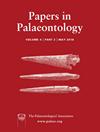Benthic pterobranchs from the Cambrian (Drumian) Marjum Konservat‐Lagerstätte of Utah
IF 2.2
2区 地球科学
Q1 PALEONTOLOGY
引用次数: 0
Abstract
Pterobranchs are rare in Cambrian strata of North America despite discoveries of more than 30 exceptionally preserved fossil biotas. Miaolingian pterobranchs from this continent typically form low‐diversity and low‐abundance assemblages. Here we describe an abundant pterobranch material from the Drumian Marjum Formation recently collected at the Gray Marjum Quarry in the House Range of Utah, USA. The faunule is composed of two new species:犹他州寒武纪(德鲁米安)Marjum Konservat-Lagerstätte 的底栖翼手类动物
尽管发现了 30 多种保存特别完好的生物化石,但北美洲寒武纪地层中的翼手目动物非常罕见。该大陆的庙岭期翼鳃类通常形成低多样性和低丰度的组合。在这里,我们描述了最近在美国犹他州豪斯山脉的格雷-马朱姆采石场采集到的来自德鲁米安-马朱姆地层的大量翼手目动物材料。该动物群由两个新物种组成:Sphenoecium marjumensis 是一种包壳代表,形成紧凑的灌木丛状群落,有 80 多个管,根茎发育不良;Tarnagraptus cupidus 是一种直立生长的类群,其特征是茎交织在一起,呈单足状群落生长。这种群落生长模式在现生的横纹翼手目动物中已知,但迄今为止从未在化石翼手目动物中观察到过。在一个距今约 500 年的类群中发现这种模式证明了它在该类群进化史中的深远渊源。虽然新物种几乎只出现在马朱姆地层中,但这一翼鳃动物群在属级组成、物种丰富度和生态结构方面与北美其他米奥利安伯吉斯页岩型沉积中发现的翼鳃动物群大体相似。这可能表明,翼手目动物在当时的动物群落中多样性很差,或者它们大多在较近的陆架环境中繁衍生息,那里很少形成有利于翼手目动物保存的条件。在北美洲的苗岭系(Miaolingian Series)中,具有根本不同形态的类群同时出现,这有力地说明了在早寒武纪,底栖翼手类动物形态多样化的早期阶段,而化石对这一阶段的记录仍然不足。
本文章由计算机程序翻译,如有差异,请以英文原文为准。
求助全文
约1分钟内获得全文
求助全文
来源期刊

Papers in Palaeontology
PALEONTOLOGY-
CiteScore
4.50
自引率
4.30%
发文量
55
期刊介绍:
Papers in Palaeontology is the successor to Special Papers in Palaeontology and a journal of the Palaeontological Association (www.palass.org). The journal is devoted to the publication of papers that document the diversity of past life and its distribution in time and space.
Papers in Palaeontology is devoted to the publication of papers that document the diversity of past life and its distribution in time and space. As a sister publication to Palaeontology its focus is on descriptive research, including the descriptions of new taxa, systematic revisions of higher taxa, detailed biostratigraphical and biogeographical documentation, and descriptions of floras and faunas from specific localities or regions. Most contributions are expected to be less than 30 pp long but longer contributions will be considered if the material merits it, including single topic parts.
The journal publishes a wide variety of papers on palaeontological topics covering:
palaeozoology,
palaeobotany,
systematic studies,
palaeoecology,
micropalaeontology,
palaeobiogeography,
functional morphology,
stratigraphy,
taxonomy,
taphonomy,
palaeoenvironmental reconstruction,
palaeoclimate analysis,
biomineralization studies.
 求助内容:
求助内容: 应助结果提醒方式:
应助结果提醒方式:


